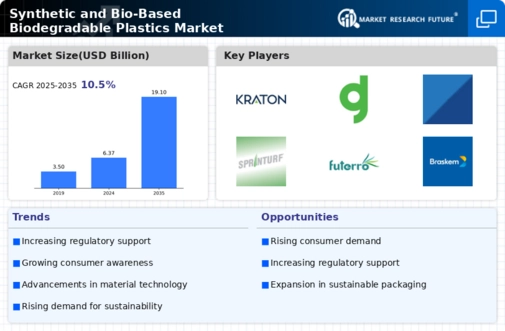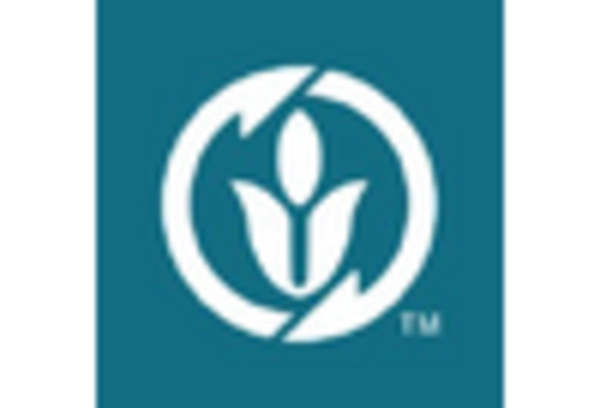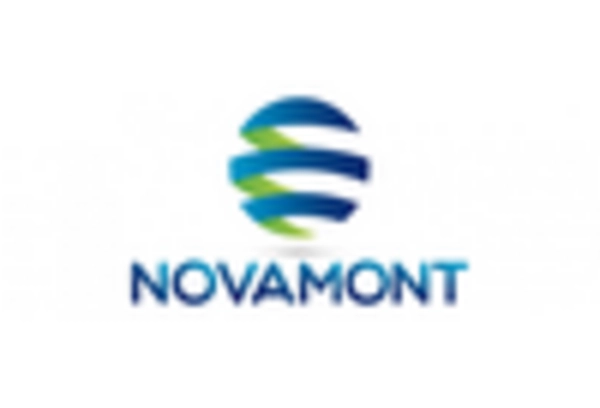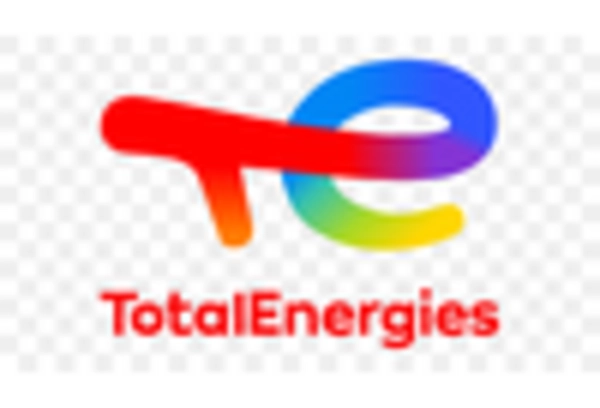Increasing Environmental Awareness
The rising awareness regarding environmental issues is a pivotal driver for the Synthetic and Bio-Based Biodegradable Plastics Market. Consumers are increasingly concerned about plastic pollution and its detrimental effects on ecosystems. This heightened consciousness has led to a surge in demand for sustainable alternatives, including biodegradable plastics. According to recent data, the biodegradable plastics segment is projected to grow at a compound annual growth rate of over 15% in the coming years. This trend indicates a shift in consumer preferences towards products that minimize environmental impact, thereby propelling the growth of the Synthetic and Bio-Based Biodegradable Plastics Market. Companies are responding by innovating and expanding their product lines to include biodegradable options, which further fuels market expansion.
Rising Demand from Packaging Sector
The packaging sector is experiencing a notable shift towards sustainable materials, significantly impacting the Synthetic and Bio-Based Biodegradable Plastics Market. As consumers increasingly prefer eco-friendly packaging solutions, companies are compelled to adopt biodegradable plastics to meet this demand. The packaging industry accounts for a substantial portion of the overall plastic consumption, and the transition to biodegradable options is expected to drive market growth. Recent studies indicate that the biodegradable packaging segment is anticipated to grow at a rate of 14% annually. This trend reflects a broader movement towards sustainability in consumer products, thereby enhancing the prospects for the Synthetic and Bio-Based Biodegradable Plastics Market. As brands seek to improve their environmental footprint, the demand for biodegradable packaging solutions is likely to continue its upward trajectory.
Government Regulations and Initiatives
Government regulations aimed at reducing plastic waste are significantly influencing the Synthetic and Bio-Based Biodegradable Plastics Market. Many countries have implemented stringent policies to limit the use of conventional plastics, thereby encouraging the adoption of biodegradable alternatives. For instance, bans on single-use plastics and incentives for using eco-friendly materials are becoming more prevalent. These regulatory frameworks not only promote environmental sustainability but also create a favorable market environment for biodegradable plastics. The market is expected to witness a substantial increase in demand as businesses comply with these regulations, leading to an estimated growth rate of 12% annually in the Synthetic and Bio-Based Biodegradable Plastics Market. This regulatory push is likely to drive innovation and investment in biodegradable technologies.
Investment in Research and Development
Investment in research and development (R&D) is a significant driver for the Synthetic and Bio-Based Biodegradable Plastics Market. Companies are increasingly allocating resources to innovate and improve biodegradable materials, focusing on enhancing their properties and reducing production costs. This commitment to R&D is crucial for developing new applications and expanding the market reach of biodegradable plastics. With the global market for biodegradable plastics projected to reach several billion dollars by 2027, the emphasis on R&D is likely to yield substantial returns. Furthermore, collaborations between academic institutions and industry players are fostering innovation, leading to breakthroughs in biodegradable technology. This investment in R&D not only supports the growth of the Synthetic and Bio-Based Biodegradable Plastics Market but also positions it as a key player in the transition towards sustainable materials.
Technological Innovations in Production
Technological advancements in the production of biodegradable plastics are a crucial driver for the Synthetic and Bio-Based Biodegradable Plastics Market. Innovations in material science have led to the development of new biodegradable polymers that offer enhanced performance characteristics, such as improved strength and flexibility. These advancements not only make biodegradable plastics more competitive with traditional plastics but also expand their applications across various sectors, including packaging, agriculture, and consumer goods. The market is projected to grow as manufacturers adopt these new technologies, with estimates suggesting a potential increase in market size by 20% over the next five years. This technological evolution is essential for meeting the growing demand for sustainable materials in the Synthetic and Bio-Based Biodegradable Plastics Market.


















Leave a Comment